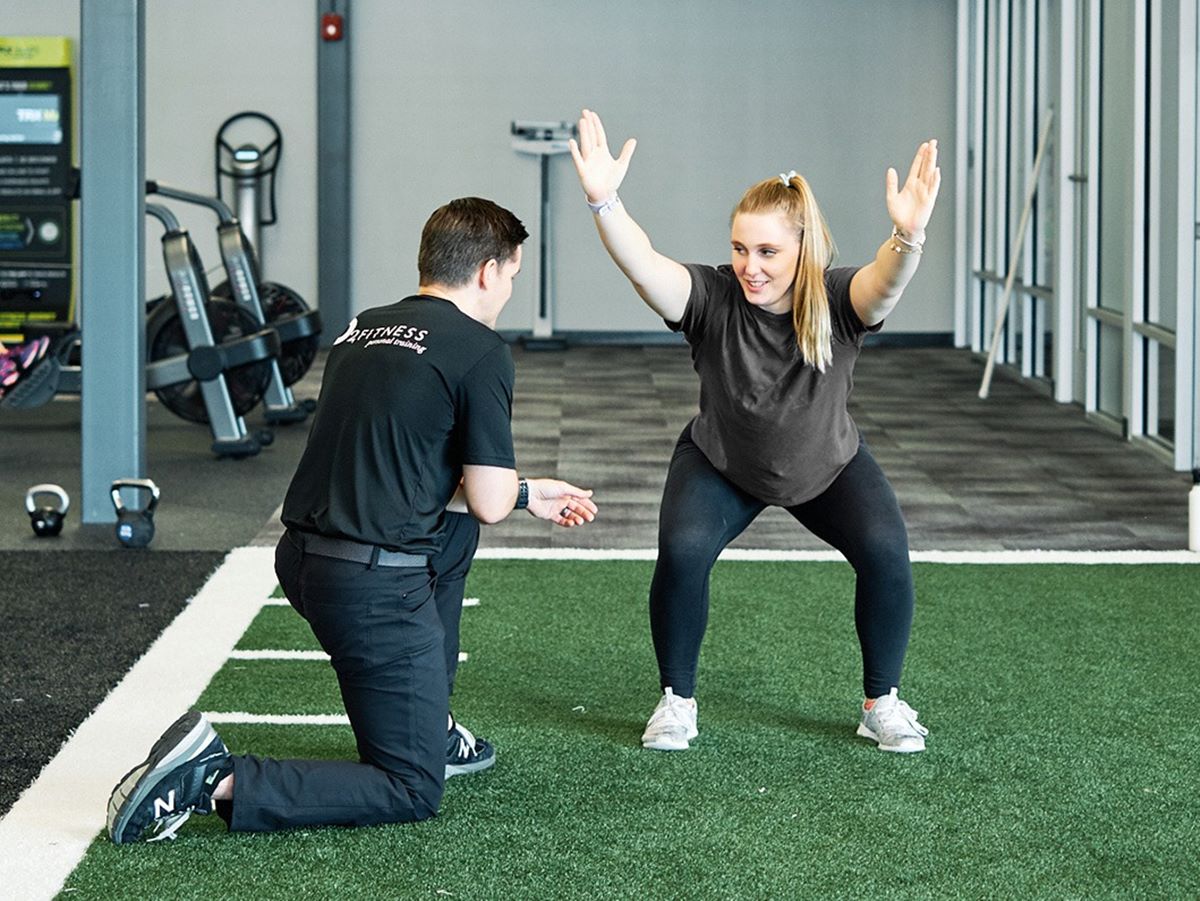Home>Misc>Featured>What Is The Best Reason To Ease Into An Exercise Program?


Featured
What Is The Best Reason To Ease Into An Exercise Program?
Published: October 1, 2023
Discover the best reason to feature an exercise program - easing into it. Start slow and gradually increase intensity for long-term success and injury prevention.
Introduction
Starting an exercise program can be both exciting and challenging. It’s important to approach it with the right mindset and strategy to ensure long-term success. While some people are eager to dive headfirst into intense workouts, it’s often beneficial to ease into an exercise program gradually. This approach allows your body to adapt to the physical demands of exercise, reduces the risk of injury, and increases your chances of sticking with it in the long run.
When you’re just getting started, it’s natural to feel motivated and inspired. However, it’s important to remember that your body needs time to adjust to new physical activities. Jumping into a rigorous exercise routine without proper conditioning can put strain on your muscles, joints, and cardiovascular system, potentially leading to injuries. By easing into an exercise program, you not only prioritize your physical safety but also set yourself up for a sustainable and enjoyable journey towards better health and fitness.
In this article, we will explore the best reasons why easing into an exercise program is the smartest approach. From reducing the risk of injury to enhancing your overall well-being, we will delve into the various benefits of starting slow and gradually increasing the intensity and duration of your workouts. By understanding the advantages of this approach, you’ll be better equipped to create a personalized exercise plan that suits your needs and goals.
Physical Safety
One of the primary reasons for easing into an exercise program is to prioritize your physical safety. Engaging in intense workouts without proper preparation can put a significant strain on your body, increasing the risk of injuries and setbacks. By gradually building up your fitness level, you give your body time to adapt to new movements and physical demands.
When you start slow and gradually increase the intensity and duration of your workouts, you allow your muscles, bones, and joints to get accustomed to the stress placed upon them. This adaptation process not only prevents injuries but also ensures that you are progressively challenging your body in a controlled manner. It gives your ligaments, tendons, and connective tissues time to strengthen and become more resilient, reducing the likelihood of strains or sprains.
Easing into an exercise program is particularly important if you have been inactive for an extended period or have certain health conditions. It allows you to assess how your body responds to exercise and identify any potential limitations or concerns. This knowledge enables you to modify your workouts and seek professional guidance if needed, ensuring a safe and effective fitness journey.
Furthermore, by starting slow, you can also prevent the onset of overuse injuries. These injuries occur when you repeatedly stress certain muscles or joints without giving them enough time to recover. Common overuse injuries include tendinitis, stress fractures, and muscle strains. By gradually increasing the intensity and duration of your workouts, you can mitigate the risk of overuse injuries and maintain a consistent exercise routine without interruptions.
Remember, exercise should be a long-term lifestyle change, not a short-term endeavor. Prioritizing your physical safety from the beginning sets the foundation for sustainable progress and prevents setbacks that could discourage you from continuing your fitness journey.
Reduced Risk of Injury
One of the key benefits of easing into an exercise program is the reduced risk of injury. When you start slow and gradually increase the intensity and duration of your workouts, you give your body time to adapt and become more resilient to the physical demands of exercise. This gradual approach helps to prevent injuries that could sideline your progress and hinder your fitness goals.
When you engage in intense workouts without proper preparation, you put yourself at a higher risk of sprains, strains, and other musculoskeletal injuries. Your muscles, tendons, and ligaments need time to adapt and become stronger, which is why starting with low-impact activities and gradually increasing the intensity is important. This progression allows your body to adjust and build a solid foundation of strength and flexibility, reducing the risk of injuries.
Furthermore, easing into an exercise program allows you to identify any physical limitations or imbalances that may increase the risk of injury. For example, if you have weak core muscles or poor posture, jumping into high-impact exercises right away can further exacerbate these issues and lead to injuries. Starting slow gives you the opportunity to address these weaknesses and imbalances through targeted exercises and proper form, which can help prevent injuries in the long run.
It’s also worth noting that some individuals may have pre-existing conditions or injuries that require extra caution. By gradually increasing the intensity of your workouts, you can better gauge how your body responds and make necessary modifications to avoid aggravating any existing injuries or conditions. This approach allows you to work with healthcare professionals or trainers to develop exercise strategies that suit your specific needs and minimize the risk of further injury.
Remember, building a strong and injury-resistant body takes time. By easing into your exercise program, you give yourself the best chance of staying injury-free and enjoying a sustainable fitness journey.
Musculoskeletal Adaptation
Easing into an exercise program allows for proper musculoskeletal adaptation, ensuring that your muscles, bones, and joints can handle the increased physical demands. When you start slow and gradually increase the intensity and duration of your workouts, your body has the opportunity to adapt and become stronger, reducing the risk of injuries and promoting overall fitness gains.
During the initial stages of an exercise program, your muscles are not accustomed to the stress and strain that physical activity places on them. By starting with low-impact activities, such as walking or light resistance training, you give your muscles time to adjust and strengthen gradually. As you continue to challenge your muscles over time, they become more efficient at using oxygen and energy, leading to increased strength and endurance.
In addition to muscular adaptation, bone health is also positively affected by easing into an exercise program. Weight-bearing exercises, such as walking, jogging, and strength training, promote bone density and strength. By progressively increasing the load on your bones, you stimulate them to become denser and more resistant to fractures and osteoporosis. Starting slow gives your bones time to adapt to the stress and helps to prevent overuse injuries, such as stress fractures, that can occur when bones are not adequately prepared for high-impact activities.
Furthermore, easing into an exercise program allows your joints to adapt to the increased movement and workload. The cartilage and synovial fluid in your joints need time to adjust to the repetitive motions and forces placed upon them during exercise. By starting with low-impact exercises and gradually increasing the intensity, you decrease the risk of developing joint pain or inflammation. This gradual progression also helps to improve joint stability and range of motion, making your workouts more effective and reducing the likelihood of joint-related injuries.
By allowing for proper musculoskeletal adaptation, you set the stage for long-term success in your fitness journey. Take the time to build a strong foundation, and your muscles, bones, and joints will thank you by becoming more resilient and capable of withstanding the challenges of more intense workouts.
Cardiovascular Adaptation
Easing into an exercise program is not only beneficial for your muscles and bones but also for your cardiovascular system. Gradually increasing the intensity and duration of your workouts allows your heart and lungs to adapt and become more efficient at delivering oxygen to your muscles.
When you engage in cardiovascular exercises, such as jogging, cycling, or swimming, your heart rate increases to meet the oxygen demands of your working muscles. By starting slow, your cardiovascular system has the opportunity to adjust to this increased demand and gradually improve its efficiency. Over time, this adaptation leads to a lower resting heart rate and increased stroke volume, meaning your heart can pump more blood with each beat.
Furthermore, easing into an exercise program helps to prevent overexertion and potential cardiovascular issues. Jumping into high-intensity workouts without proper conditioning can put unnecessary stress on your heart, increasing the risk of chest pain, heart palpitations, or even heart attacks. Starting with low-to-moderate intensity exercises and gradually increasing the intensity gives your heart time to adapt and become stronger, reducing the risk of cardiovascular complications.
Regular cardiovascular exercise also improves your body’s ability to use oxygen efficiently. As you exercise more frequently and increase the duration and intensity of your workouts, you enhance your body’s capacity to take in and utilize oxygen. This increased oxygen capacity benefits not only your cardiovascular system but also your overall endurance and performance.
By easing into your exercise routine and allowing for cardiovascular adaptation, you’re setting the stage for a healthier and more efficient cardiovascular system. Regular cardio exercise improves your cardiovascular health, reduces the risk of heart disease, and increases your overall fitness level, ensuring that you can continue to enjoy an active and fulfilling lifestyle.
Gradual Skill Development
Easing into an exercise program allows for gradual skill development, especially if you are new to a particular type of exercise or physical activity. Starting slow and gradually increasing the complexity of your movements gives you the opportunity to learn proper form, improve coordination, and develop the necessary skills to perform the exercises correctly.
When you begin a new exercise or sport, it’s common to feel unfamiliar with the movements and techniques involved. By starting with simpler exercises and gradually progressing to more challenging ones, you can gradually enhance your skills and build a solid foundation. This approach allows you to focus on mastering the basics, such as proper body alignment, breathing techniques, and movement patterns, before adding more advanced elements.
Taking the time to develop your skills gradually also helps to prevent the risk of injury. Rushing into complex exercises or movements without adequate skill development can lead to poor form, compensatory movements, and strain on different parts of your body. By starting slow and progressively adding complexity, you can ensure that you’re moving with proper technique and minimize the risk of overloading certain muscle groups or joints.
Additionally, gradual skill development allows you to gauge your progress and set realistic goals. By taking small steps to improve your skills over time, you can track your progress and celebrate the small victories along the way. This sense of achievement and continuous improvement can help to boost your confidence and motivation, keeping you engaged and committed to your exercise program.
Remember, fitness is not just about how much weight you can lift or how fast you can run. It’s also about developing the skills necessary to move and function optimally. By easing into your exercise program and focusing on gradual skill development, you’re laying a solid foundation for long-term success and enjoyment in your fitness journey.
Increased Adherence
One of the significant benefits of easing into an exercise program is the increased adherence it promotes. Starting with a gradual approach allows you to establish a sustainable routine and build healthy habits that are easier to maintain over the long term.
When you embark on a new exercise program, it’s crucial to find a balance between challenging yourself and avoiding burnout. Starting slow and gradually increasing the intensity and duration of your workouts prevents excessive physical and mental fatigue that can lead to frustration and demotivation. By pacing yourself, you can find a level of effort that is challenging yet manageable, increasing your likelihood of sticking with the program.
Moreover, easing into an exercise program allows you to listen to your body and adjust the intensity based on how you feel. This approach helps you avoid potential setbacks due to overexertion or injury. By being in tune with your body’s needs and limitations, you can make modifications when necessary and prevent discouragement from unexpected roadblocks.
In addition, taking a gradual approach gives you the opportunity to develop a positive mindset towards exercise. By starting with activities that you enjoy and can comfortably perform, you build confidence and create a positive association with working out. As you progress, you can introduce new exercises or variations to keep your routine engaging and exciting. This variety helps to prevent boredom and keeps you motivated and committed to your exercise program.
Furthermore, starting slow and gradually increasing the intensity helps to develop a sense of accomplishment and progress. As you see improvements in your strength, endurance, or skill level, it reinforces your commitment to continue and pushes you to reach new milestones. This positive reinforcement strengthens your adherence and helps you develop a long-term exercise habit.
By embracing a gradual approach to your exercise program, you increase your adherence and establish healthy habits that are more likely to be sustained over time. Consistency is key in reaching your fitness goals, and starting slow sets the stage for lasting success in your journey toward better health and well-being.
Long-term Habit Formation
Easing into an exercise program is crucial for the formation of long-term habits. When you take a gradual approach, you give yourself the opportunity to develop a sustainable routine that becomes a natural part of your daily life.
Building a new habit takes time and consistency. By starting slow and gradually increasing the intensity and duration of your workouts, you create a manageable pace that allows you to integrate exercise into your daily routine without overwhelming yourself. This gradual progression helps to establish the habit of regular physical activity and ensures that it becomes a sustainable part of your lifestyle.
Adopting a gradual approach also helps to overcome common barriers to habit formation, such as time constraints and lack of motivation. By starting with shorter, less time-consuming workouts and gradually increasing the duration, you make it easier to find pockets of time in your schedule for exercise. This approach also prevents burnout and increases your chances of staying committed, as you gradually build up your fitness level and feel more motivated to continue.
Moreover, a gradual approach allows you to start with activities that you enjoy and that align with your preferences and interests. By choosing exercises that you find enjoyable and engaging, you increase the likelihood of sticking with them in the long run. As you gradually progress, you can explore new activities or variations to keep your routine fresh and exciting, further reinforcing the habit of regular exercise.
Additionally, starting slow and gradually increasing the intensity helps to prevent the feeling of being overwhelmed or discouraged by the demands of a new exercise program. It allows you to focus on small, achievable goals and celebrate your progress along the way. These small wins build confidence and motivation, making it easier to maintain the habit and continue progressing toward your fitness goals.
By embracing a gradual approach to your exercise program, you set yourself up for long-term habit formation. Consistency is key when it comes to reaping the benefits of regular physical activity, and by starting slow and building up gradually, you establish a sustainable routine that becomes ingrained in your daily life.
Increased Enjoyment and Motivation
Easing into an exercise program can significantly increase your enjoyment and motivation. By starting slow and gradually increasing the intensity and duration of your workouts, you create a positive and sustainable exercise experience.
When you take a gradual approach, you have the opportunity to find activities and exercises that you genuinely enjoy. By starting with exercises that align with your interests and preferences, you increase the likelihood of sticking with them in the long run. Whether it’s dancing, hiking, yoga, or team sports, finding activities that bring you joy makes exercise feel less like a chore and more like a fun and rewarding experience.
Furthermore, easing into an exercise program allows you to explore and discover new activities or variations as you progress. This variety keeps your workouts fresh and exciting, preventing boredom and monotony. Trying new exercises or joining group classes can add an element of novelty and bring a sense of anticipation and fulfillment to your routine.
Additionally, a gradual approach helps to prevent overwhelm and burnout, which can often demotivate individuals from continuing with their exercise program. By starting with manageable intensity and duration, you can build confidence and gradually increase the challenge at a pace that suits you. This approach allows you to feel a sense of accomplishment and progress, which motivates you to keep going and further improve.
Setting small, achievable goals along the way can also enhance your motivation. By celebrating each milestone or personal best, you create a positive feedback loop that reinforces your dedication and commitment. This positive reinforcement increases your overall motivation to continue progressing and achieving new milestones.
Additionally, easing into an exercise program allows you to develop a healthier relationship with exercise. By avoiding drastic changes and extreme workouts, you can view exercise as a source of self-care and a way to enhance your physical and mental well-being. This mindset shift can significantly impact your long-term adherence and enjoyment of exercise, leading to lifelong benefits.
By gradually easing into an exercise program, you create an environment of enjoyment and motivation. Finding activities that you love, adding variety to your routine, setting achievable goals, and approaching exercise as self-care all contribute to a positive exercise experience, making it easier to stay committed and motivated in the long run.
Enhancement of Overall Well-being
Easing into an exercise program not only benefits your physical health but also enhances your overall well-being. Regular physical activity has a profound impact on your mental, emotional, and social well-being, leading to a higher quality of life.
Exercise has been shown to release endorphins, which are known as “feel-good” chemicals in the brain. These endorphins promote a sense of happiness, reduce stress, and improve mood. By starting slow and gradually increasing the intensity of your workouts, you can tap into these mood-enhancing benefits. Regular exercise has also been linked to reduced symptoms of anxiety and depression, contributing to improved mental health and well-being.
In addition to the immediate mood boost, exercise has long-term effects on your mental well-being. Establishing a regular exercise routine improves your self-esteem and body image as you feel stronger, fitter, and more confident in your abilities. This positive self-perception carries over into other aspects of your life, fostering a more positive mindset and increased self-worth.
Engaging in physical activity also provides a much-needed opportunity to unplug from the stresses and demands of daily life. Whether it’s a refreshing walk outdoors or an invigorating workout at the gym, exercise can serve as a form of stress relief and mental relaxation. It allows you to clear your mind, reduce tension, and improve your ability to manage stress. By dedicating time to physical activity, you prioritize your mental well-being and cultivate a sense of balance in your life.
Furthermore, participating in group exercise classes or team sports can enhance your social well-being. It provides an opportunity to connect with others who share similar interests and goals. The social aspect of exercise can foster a sense of belonging, camaraderie, and support. Building relationships and connections through exercise can contribute to a healthier and more fulfilling social life.
Taking a gradual approach to your exercise program also minimizes the risk of burnout and helps you maintain a healthy balance in your life. By gradually integrating exercise into your routine, you have the flexibility to prioritize other aspects of well-being, such as sleep, nutrition, and relationships. This holistic approach to well-being ensures that exercise complements and enhances your overall lifestyle, rather than becoming a source of additional stress or pressure.
By easing into an exercise program, you enhance not only your physical fitness but also your overall well-being. Improved mental health, increased self-esteem, reduced stress, and enhanced social connections are just a few of the many benefits you can experience. Remember, exercise is a powerful tool for enhancing your overall quality of life and promoting a sense of well-being.
Conclusion
In conclusion, easing into an exercise program is the best approach for several reasons. Prioritizing physical safety by gradually increasing the intensity and duration of workouts reduces the risk of injuries and ensures a sustainable fitness journey. The musculoskeletal and cardiovascular adaptations that occur when starting slow help to strengthen the body, improve endurance, and prevent overuse injuries. Gradual skill development allows for proper form, coordination, and progression of exercises, promoting efficiency and reducing the risk of strain. Moreover, taking a gradual approach increases adherence by finding a balance that is challenging yet manageable, preventing burnout and enhancing long-term commitment. This gradual progression also leads to the formation of long-term habits, making exercise a natural part of daily life. Additionally, easing into an exercise program promotes increased enjoyment and motivation by allowing for variety, setting achievable goals, and creating a positive exercise experience. Finally, exercise, when approached gradually, enhances overall well-being by improving mental health, reducing stress, and fostering social connections.
Whether you are a beginner or returning to exercise after a break, remember that a gradual approach is key to long-term success and enjoyment. Listen to your body, start slow, and gradually increase the intensity and duration of your workouts. Consult with a healthcare professional or a certified fitness trainer to design an exercise program that suits your needs and goals. Embrace the process, celebrate your progress, and prioritize your overall well-being as you embark on your fitness journey. Remember, it’s not just about reaching a destination; it’s about enjoying the journey, building sustainable habits, and living a healthier and more fulfilling life.







